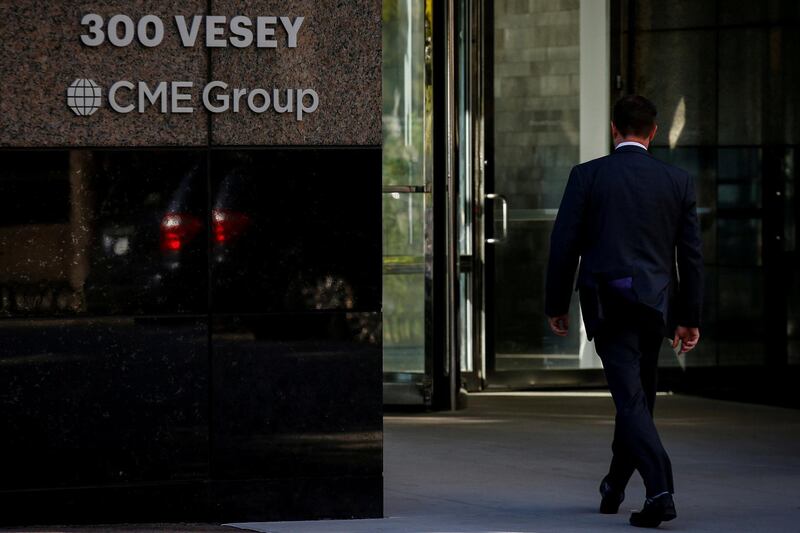The world’s biggest exchange just joined the bitcoin revolution.
Bitcoin futures started trading Sunday night at CME Group’s venue, a week after Chicago rival Cboe Global Markets introduced similar derivatives on the volatile cryptocurrency. CME is a much bigger player in futures, so many traders expected it to make a bigger splash in the nascent space.
CME got off to a faster start with more efficient pricing. Its most-active contract changed hands 221 times in the first hour versus 570 during Cboe’s debut. But that’s a win because CME’s contracts are five times more valuable — they’re tied to five bitcoins compared with only one with Cboe’s futures.
“People were better prepared” for the start of trading at CME, said Bobby Cho, head of trading at Cumberland, the cryptocurrency trading unit of DRW Holdings LLC. “They knew how they were going to hedge their positions.”
CME’s futures traded at about 2 per cent above bitcoin itself as of 11:56am in London; in the first day, Cboe’s got as much as 13 per cent above, a sign trading was relatively inefficient. Bitcoin on Monday climbed 9 per cent from its Friday New York close to US$19,190, approaching the record $19,511 reached hours earlier.
____________
Read more:
PayPal founder Max Levchin talks bitcoin and digital payments
Four reasons not to count out gold just yet
____________
The CME and Cboe bitcoin futures have some distinct features. The price of Cboe’s product is derived from the cryptocurrency’s price at a single exchange; CME’s is based off four.
“We were waiting for the launch of the CME futures because the price is more robust and the exchange trades much larger volumes,” Jose Miguel Nascimento, head trader at cryptocurrency fund Solidus Capital, said in a telephone interview from Mexico City. “Futures are a very positive development for the bitcoin market, as it will help everyone from miners to traders hedge risk, and having a price curve will help limit price swings.”
The CME futures are another step into the mainstream financial world for an asset created in the wake of the 2008 financial crisis as an alternative to banks and government-issued currencies. The contracts, which settle in dollars and trade on regulated exchanges, can be bought by institutional investors that are prohibited from buying bitcoin directly on largely unregulated exchanges.
“One of the biggest issues when it comes to investing institutionally in digital assets is banks and larger institutions can’t hold an unregulated instrument in their balance sheet, and a futures contract is something they can hold,” said Gabor Gurbacs, director of digital-asset strategy at VanEck Associates. With futures, “you don’t hold the physical bitcoin, which solves custody issues and counterparty risks with these less-regulated exchanges.”
To protect against wild, mistaken price swings, CME will briefly pause trading if the contracts rise or fall 7 per cent or 13 per cent, and prices won’t be allowed to move more than 20 per cent. That wasn’t necessary in its debut. Cboe also has volatility halts, which were triggered in the initial hours of trading a week ago, and its January contract rose as much as 26 per cent on the first day.
Cboe’s website stalled during its launch. CME’s seemed to weather the traffic.
“It’s only one-lots,” said Garrett See, chief executive officer of crypto trading firm DV Chain of the initial CME trades. “The prices are moving around pretty fast.” The order book was pretty thin and “the orders that are there are very small.”
Futures open up arbitrage opportunities — the chance to bet prices of the derivatives and the underlying cryptocurrency will converge. Last week, Cboe’s product was priced as much as 13 per cent higher than bitcoin, but that quickly narrowed. By Sunday night, it was similar to CME’s.
Some brokerages didn’t immediately give customers access to bitcoin futures. TD Ameritrade Holding said late Friday that it will offer Cboe’s starting on Monday, though it’ll wait to offer the CME contracts until they demonstrate sufficient liquidity. E*Trade Financial is considering offering bitcoin futures, according to a person familiar with the matter who asked not to be named.
“We look at the volume, the open interest and the spreads, and we want to make sure that all those conditions are maturing properly,” said JB Mackenzie, managing director for futures trading at TD Ameritrade. “We have had a lot of customer interest, and we have spent a lot of time educating them as to the differences between the two products.”
Banks and brokers who are offering access are being cautious. Goldman Sachs Group demanded some clients set aside collateral equal to 100 per cent of the value of their trades, people familiar with the investments said last week. The guidelines are inclusive of other margin requirements such as Options Clearing Corp.’s 44 per cent, required to clear contracts traded at Cboe, and the 47 per cent CME is demanding.
It’s not uncommon for a brokerage to impose steeper requirements than the exchange. Interactive Brokers Group, which has said it handled 53 per cent of the first day’s trading in Cboe’s bitcoin futures, will require a margin of 50 per cent for long investments, and about 240 per cent for short selling, based on current rates, according to Interactive Brokers spokeswoman Kalen Holliday.






